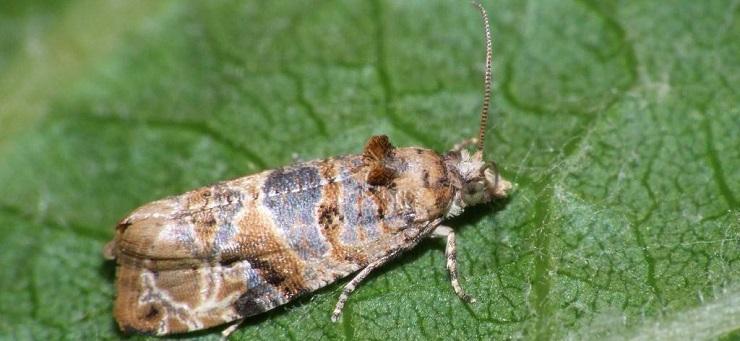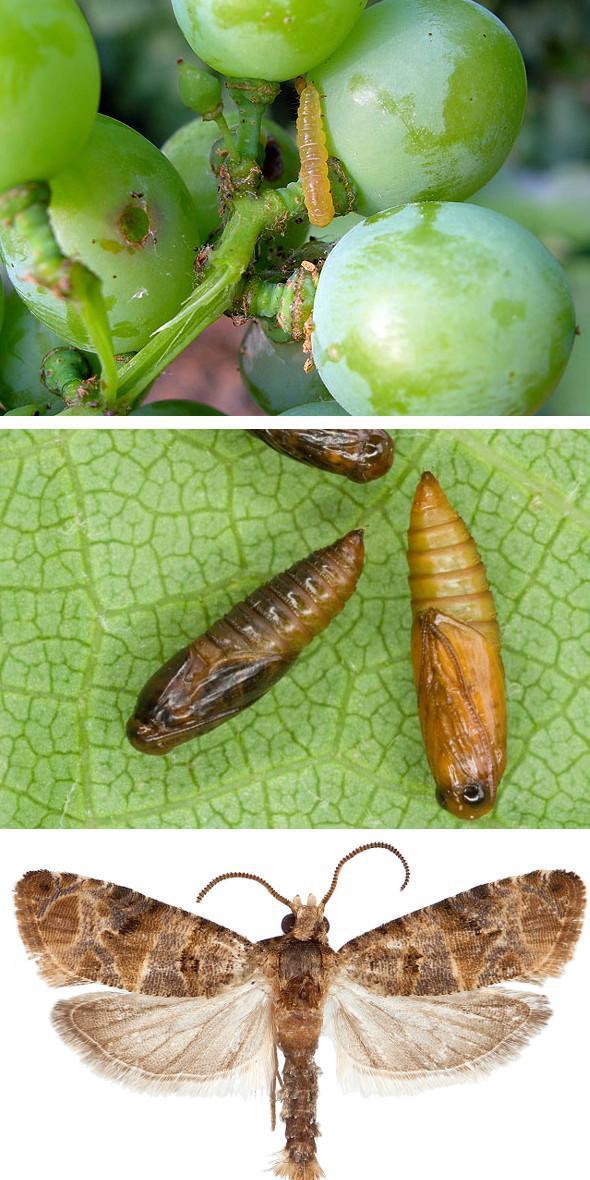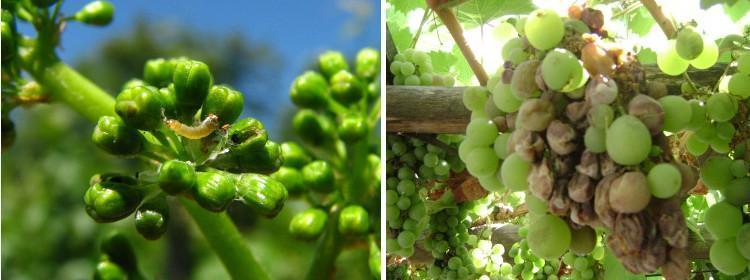European grapevine moth (Lobesia botrana) – pest management

Prevalence. The European grapevine moth is a common species in southern Europe and North Africa.
Description. The adult is a 7-8 mm long butterfly, with a wingspan of 18-20 mm. The forewings have brown spots that alternate with gray-blue spots. The hind wings are gray, fringed. The larva is a green-olive-gray caterpillar, with a length of 10-12 mm and it has a brown head, pronotum, and legs.
Biology
The European grapevine moth produces 2-3 generations per year and overwinters in the pupa stage under the exfoliated bark of the stumps, in a silky white cocoon. Adults appear when the temperature exceeds 15º C and fly at twilight. Usually, they appear in May-June, they feed for 10-12 days, after which they copulate and lay eggs. The female lays about 50-80 eggs for a month, alone or in small groups, usually on flower buds, less often on leaves or shoots. The second and third generations lay their eggs on green grapes or in dough ripeness. The flight of butterflies and the laying of eggs are favored by high temperatures and drought, but the direct action of the sun’s rays on the eggs leads to their destruction (up to 50% of the eggs are destroyed).
The first larvae appear at the beginning of June and their development lasts 25-32 days after which the larvae build a silky cocoon to turn into a pupa. The pupal stage lasts 8-12 days, then the adults of the first generation appear, in the first half of July.
This pest is a trivoltine species (it produces 3 generations per year): the first generation develops in May-June, the second generation in July-August, the third generation in August-May.
Attacked plants and damages
In addition to the grapevine, the European grapevine moth also attacks blackberries, currants, plums, and nectarines. The pest is harmful in the larval stage, feeding on over 20 species. The signs of the attack are obvious by the presence of larvae and silk on the bunches, under the bark of the older stumps and tendrils.
First-generation larvae feed on flower buds and youngberries. A larva can consume up to 80 buds during its development. Second-generation caterpillars attack green or berries in dough ripeness and third-generation larvae damage in dough ripeness or ripe berries. The attacked berries darken in color and shrivel up. The larvae surround the attacked organ with white silky threads. The second and third-generation caterpillars cause the most damage. Due to the wounds caused, the pathogenic fungus Botrytis cinerea penetrates the plant. The wine obtained is of inferior quality and cannot be kept.
Lobesia botrana is, after phylloxera, the most dangerous pest of the grapevine.
Control
Applying the measures provided by the technology of grapevine cultivation that contributes to the more vigorous growth of the plants helps to reduce the damage caused by this pest.
Pests with pheromones are used for biological control for capturing the males, severely disrupting the mating process. Some biological insecticides, obtained from pathogenic bacteria, can also be used against the European grapevine moth.
The control of the European grapevine moth is usually done preventively because the larvae of the pest are sensitive to the action of pesticides if applied immediately after hatching. The second and third-generation larvae, after penetrating the fruit, are no longer affected by insecticides, the treatments being useless in this case.
The first treatment has to be applied during flowering (with insecticides that protect the useful entomofauna). The second is the dough ripeness phenophase. In heavily infested areas, it is recommended to carry out a third treatment, 20-25 days before harvest, with products with reduced toxicity.
The treatments are performed with specific insecticides.
Recommended products
-
You can find products on a different store
Change Store -
You can find products on a different store
Change Store -
You can find products on a different store
Change Store -
You can find products on a different store
Change Store -
You can find products on a different store
Change Store -
You can find products on a different store
Change Store -
You can find products on a different store
Change Store -
You can find products on a different store
Change Store -
You can find products on a different store
Change Store -
You can find products on a different store
Change Store -
You can find products on a different store
Change Store -
You can find products on a different store
Change Store -
You can find products on a different store
Change Store -
You can find products on a different store
Change Store -
You can find products on a different store
Change Store -
You can find products on a different store
Change Store -
You can find products on a different store
Change Store -
You can find products on a different store
Change Store -
You can find products on a different store
Change Store -
You can find products on a different store
Change Store -
You can find products on a different store
Change Store -
You can find products on a different store
Change Store -
You can find products on a different store
Change Store -
You can find products on a different store
Change Store

















































































































































































































































































































































































































































